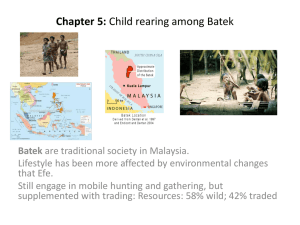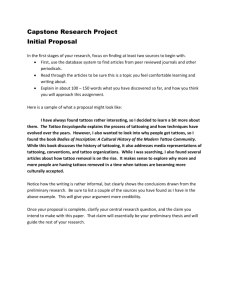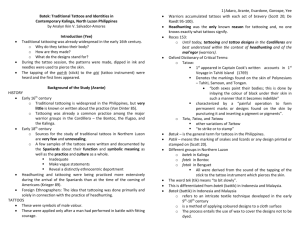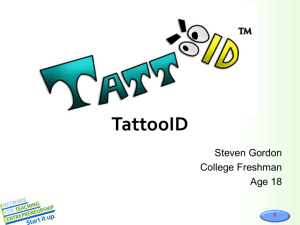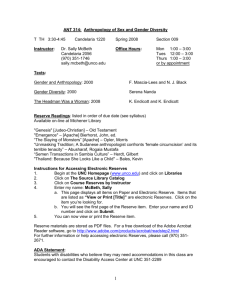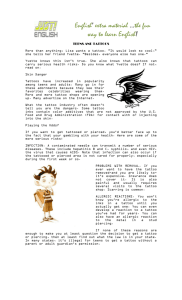Research papel - Indigenous Body Adornment
advertisement
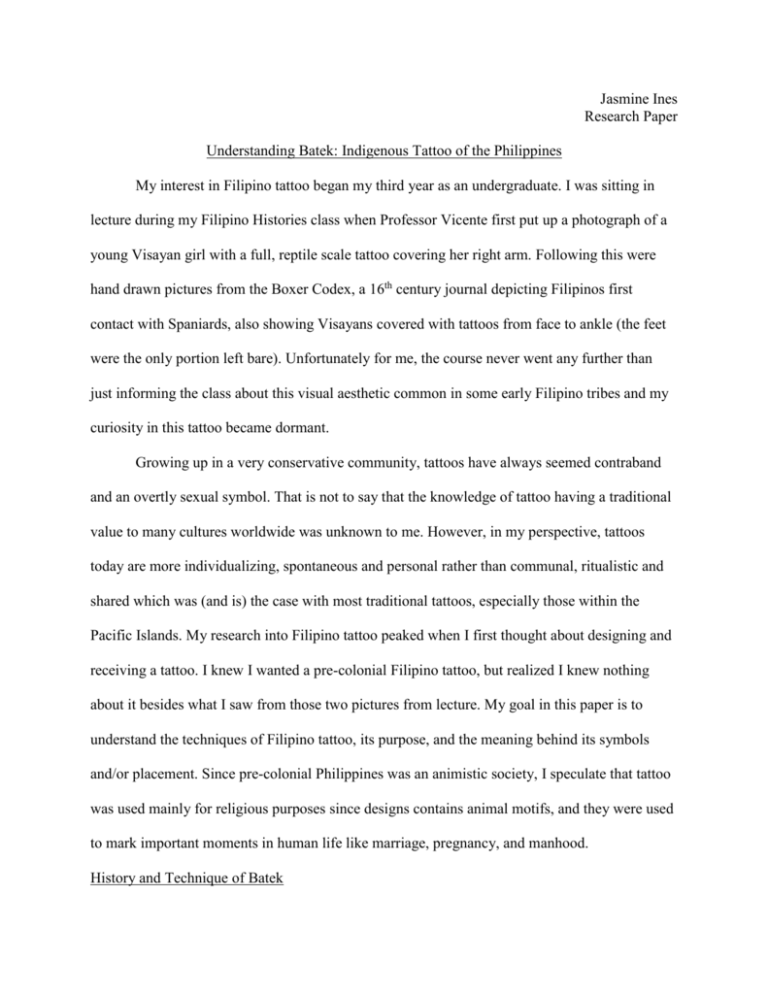
Jasmine Ines Research Paper Understanding Batek: Indigenous Tattoo of the Philippines My interest in Filipino tattoo began my third year as an undergraduate. I was sitting in lecture during my Filipino Histories class when Professor Vicente first put up a photograph of a young Visayan girl with a full, reptile scale tattoo covering her right arm. Following this were hand drawn pictures from the Boxer Codex, a 16th century journal depicting Filipinos first contact with Spaniards, also showing Visayans covered with tattoos from face to ankle (the feet were the only portion left bare). Unfortunately for me, the course never went any further than just informing the class about this visual aesthetic common in some early Filipino tribes and my curiosity in this tattoo became dormant. Growing up in a very conservative community, tattoos have always seemed contraband and an overtly sexual symbol. That is not to say that the knowledge of tattoo having a traditional value to many cultures worldwide was unknown to me. However, in my perspective, tattoos today are more individualizing, spontaneous and personal rather than communal, ritualistic and shared which was (and is) the case with most traditional tattoos, especially those within the Pacific Islands. My research into Filipino tattoo peaked when I first thought about designing and receiving a tattoo. I knew I wanted a pre-colonial Filipino tattoo, but realized I knew nothing about it besides what I saw from those two pictures from lecture. My goal in this paper is to understand the techniques of Filipino tattoo, its purpose, and the meaning behind its symbols and/or placement. Since pre-colonial Philippines was an animistic society, I speculate that tattoo was used mainly for religious purposes since designs contains animal motifs, and they were used to mark important moments in human life like marriage, pregnancy, and manhood. History and Technique of Batek Filipino tattoo is generally called batuk, but also goes by other names among the island depending of which dialect is the spoken norm of the area. The variants I came across are all similar in structure such as batek, batok, patik, patek, fatok and fatek to name a few and derive from the sound made when receiving a batek (Salvador-Amores, 108). While batek was not practiced on all areas of the island, the tribes who were “distinguishable based on tattoos” (Finin, 35) were those in the central Visayas and in Northern Luzon in the mountain provinces of the Kalinga. In the southern islands, the majority of the population was Muslim and therefore did not have tattoos because it was prohibited by their religious beliefs. The artist creating the batek is called a manbatek, or mambabatok. During the dominance of batek, there was one manbatek present in each village or at least one in each tribe. Tribes without access to a manbatek had to have their tattoos done by visiting tribes, and usually in groups to compensate for his/her time (Scott, Cordillera, 86). Payment was made through the exchange of goods which depended on which section of the body was being inked. According to scholars Salvador-Amores and Krutak, there are only two known manbateks left in the Kalingas and only one is still practicing. The instruments of the manbatek are made up of two primary pieces, the pat-ik and the gisi. Like the tattooing sets of Polynesia, it is made up of a tapping stick and the piercing tool, respectively. Traditionally, the gisi was made of the horn of a carabou that was bent over fire so it created a right angle with the point facing downward. Four needles were attached to the tip of the gisi which were either made of orange or lemon thorns. The pat-ik, which literally translates to stick, was used to hit the gisi onto the skin (Salvador-Amores, 109). The ink, merteka, was made of a mixture of soot and water. Candlenut was common around the Kalingas and was the usual choice in creating soot. However, while in Hawaiian and Samoan cultures only the shell was burnt, all parts of the candlenut would be charred and utilized such as the leaves and sap (Krutak, Women, 103). In the special case of the Ibanag tribe, a batek was “applied with hog bile and ink” (Scott, Barangay, 264) although the purpose of mixing bile with the ink was never mentioned. A coconut shell or turtle shell was used to hold the ink, however other items were substituted depending on available resources and preference. The technique involved in the final creation of a batek was relatively simple. Most commonly during a session, “a pattern was made [in bark], dipped in ink” (Salvador-Amores, 108), and stamped on the body. The body stamp was them filled using the gisi and pat-ik. Another method was to trace the curve of fern leaves when creating bigger designs like those on the chest. The biggest different in this technique from other tapping tattoo cultures was the placement of the hands. In all Polynesia cultures, tapping is done hand over hand- with the back of one hand facing the palm of the other during the session. However, the batek involves holding the instruments so the back of the hands are facing each other instead, a technique called “backhanding” (Krutak, Kalinga article). Batek was made on one body part at a time, taking from one day to a week to finish. The healing process then lasted from one to three months afterwards (Salvador-Amores, 109). I would also like to point out that while the Philippines is an island nation and is commonly associated with Polynesia, it is culturally more closely “linked…to other Austronesian-speaking populations inhabiting Southeast Asia” (Lars, Women, 56). This does not imply that Filipinos do not identify with Polynesian culture, traditions, or society because that would be untrue, but rather its pre-colonial influences and contacts differed from theirs. For example, while Lapita pottery heavily influenced Polynesian tattoos and designs there is no substantial evidence claiming it influenced batek. Additionally, the origin batek is similar to the myths of tattoo in Borneo and Hainan Island, China. “In each of these tales, one or two particular species of bird created tattooing for the indigenous peoples in the area to appropriate for their own use” (Krutak, Women, 74). The Purpose and Placement of Batek When foreigners first encountered batek in the 16th century, they associated it solely with the practice of headhunting (Salvador-Amores, 110). There was an obvious connection between the two, since head taking allowed the victor to receive visual markings of his accomplishment(s). However, while batek on males was a sign of distinction and valor “the exact regulations governing the application of such decorations are not clear” (Scott, Cordillera, 85). Each village seemed to have their own rules in receiving batek, and the manbatek held the power of offering these badges of honor to those deemed worthy. The first warrior tattoos given to males were “two thin horizontal bands around the bicep” (Scott, Cordillera, 85). The ultimate marking of the successful warrior was the chest tattoo which formed a v- or u-shaped design between the pectorals which were “the most popular emblems of historic headhunting cultures in Southeast Asia and the Western Pacific” (Lars, Women, 195). While the exact meaning of this symbol is unclear, it is though that the shape represents the wing span of the bird who taught tattoo to the island or is a skeuomorph depicting the body of the men they have beheaded. The most popular use of batek was to denote the different stages of a person’s life. The placement and design of these tattoos varied from tribe to tribe. In Ilubo, they had a specific batek for women before they marry which consists of getting x-marks on both cheeks, forehead, and chin. It was used primarily for pregnancy and childbirth to disguise them from spirits wanting to harm them or their children. It was also used for protective purposes against evil forces and promotes good health (Salvador-Amores, 113-114). Similarly, before men wed it was required to have tattoos to ensure their wife’s agreement to the proposal as it proved virility and prestige. Like the pe’a and malu of Samoa, the batek “indicat[d] initiation into adulthood and full participation in the social life of the group (Salvador-Amores, 118). In some instances, men and women are only allowed to become village elders if they have acquired the proper tattoos. Socially, it marked villagers’ rank in society as well as certain life stages. More so, Filipino batek was also used just for decoration. Some tribes like the Madukayans claim all their tattoos “are only decorations and have no connection with headtaking (Scott, Cordillera, 86). Beaded necklaces were popular among Filipinas, so although they were not common, necklace tattoos were visible. Additionally, the placement of batek could be considered decorative. For example, some tribes favored face tattoos while some viewed them as repulsive and disfiguring. Decorative batek was used at times as a form of talisman, too. Protective motifs consisted of beasts like centipedes, birds, and snakes. Warrior’s wives were encouraged to be tattooed because it was believed “the souls of women who were not so decorated could not enter that land of the dead” (Scott, Barangay, 264). Although the practices of batek differed from tribe to tribe, conformity within tribes was required in regards to tattoos. So if you belonged to a heavily tattooed community, failure to concentrate your body with the needed amount led to the disapproval or ostracization from the rest of the village. Conclusion The use of batek within Filipino society had many purposes, the obvious one creating a sense of community and identity within a tribe. It united a village aesthetically, but could also show off individual achievements, distinctions, and events. The reason for receiving a batek varied from each tribe but included prestige, beauty, fertility, protection charms, rite of adulthood, accomplishments, and conformity. My early speculation that batek was used religiously was not proved through my research although I would argue there is a sense of spiritually associated with getting a batek, the bloodletting, and suffering the open wounds while it healed. Additionally, the animal motifs used within protective tattoos in essence shows the respect for other living creatures on the island. The second theory I had about batek being referencing special life events was proven since it could portray rites of passage in life. Overall, now that I know more about the traditional background of Filipino tattoos I am still unsure about receiving one myself. In Krutak’s web article, which introduced the audience to the last known practicing manbatek, she only offered the chest batek to a man who had recently killed men from a neighboring village in revenge for murdering on of their elders. Realistically, it may even be impossible for me to get a batek due to the rarity of manbateks and the regulations following receiving a batek from the last known tattoo artist’s tribe. Bibliography Finin, Gerard A. Making of the Igorot Contours of Cordillera Consciousness. New York: University of Hawaii P, 2007. Krutak, Lars. The Tattooing Arts of Tribal Women. London, England: Bennet & Bloom/Desert Hearts, 2007. "Lars Krutak - THE LAST KALINGA TATTOO ARTIST OF THE PHILIPPINES." Lars Krutak - Tattoo Anthropologist. 26 May 2009 <http://www.larskrutak.com/articles/Philippines_/index.html>. Salvador-Amores, Analyn Ikin V. “Batek: Traditional Tattoos and Identities in Contemporary Kalinga, North Luzon Philippines.” PhD Thesis, University of Oxford, 2002. Scott, William Henry. Barangay sixteenth-century Philippine culture and society. Quezon City, Manila, Philippines: Ateneo de Manila UP, 1994. Scott, William Henry. On the Cordillera. Manila: MCS Enterprises, INC., 1966 Photo Pages Traditional gisi and pat-ik Traditional and modern batek Centipede and star batek A batek session Warrior chest tattoo Chest batek close up Women’s arm batek
